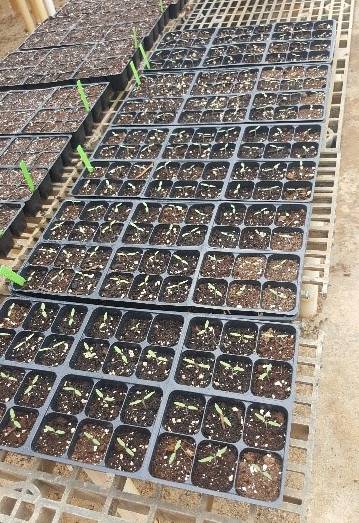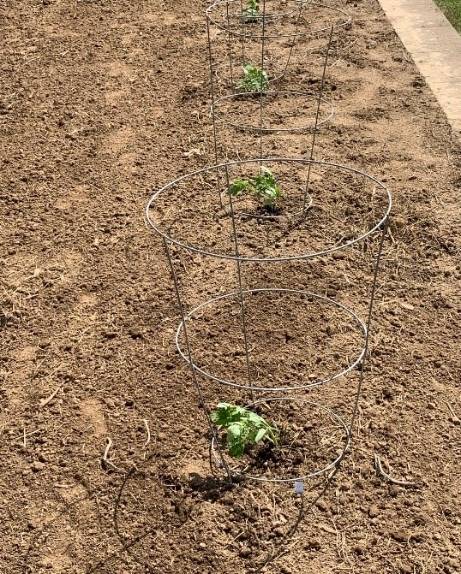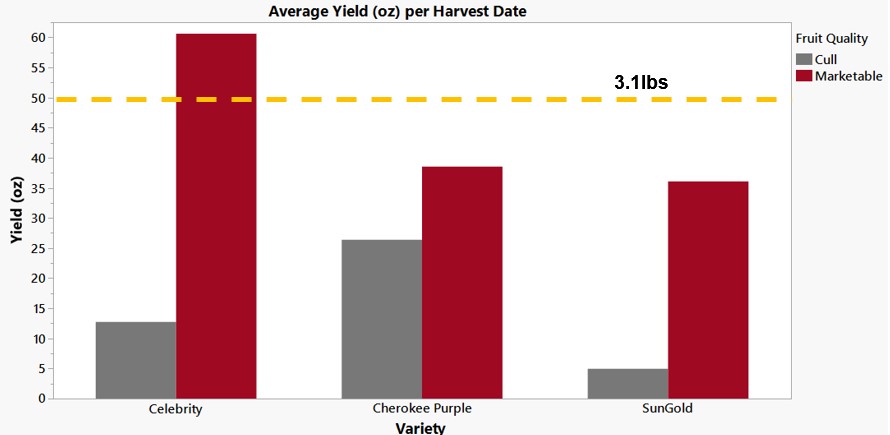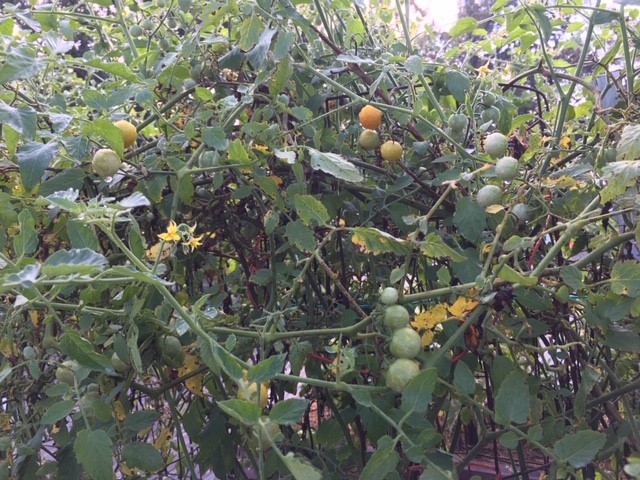
2019 County Agent Tomato Variety Demo

Photo cred: Richard Klerk, Faulkner Co.
Grow tomatoes? Check out the results from the 2019 tomato demonstration where county agents compared the performance of three tomato varieties, Celebrity, SunGold and Cherokee Purple, throughout the state of Arkansas!
Have tomatoes in your garden? You’re not alone! Tomatoes are one of the most popular garden vegetables grown in Arkansas and are commercially grown on a large scale in the southeastern part of the state. While there are hundreds of tomato varieties to choose from, some are more adapted to our conditions than others. Below is a table from a tomato fact sheet written by Craig R. Andersen with recommended tomato varieties for Arkansas (Figure 1).

Figure 1. Table of tomato varieties recommended for Arkansas with various descriptions for each variety such as crop type and tolerance or resistance to diseases.

Figure 2: Tomato transplants in greenhouse on March 20th, 2019 (Hope, AR)
In order to evaluate how some common tomato varieties perform across the state and introduce new varieties a demonstration with University of Arkansas Cooperative extension service county agents was conducted in 2019. The demonstrations compared the performance of three tomato varieties, Celebrity, SunGold, and Cherokee Purple at different locations throughout the state. These three varieties represent a standard slicer type, an heirloom type and a small cherry tomato type. Seeds were seeded into flats in late March and grown in the greenhouse at the Southwest Research and Extension Center in Hope, AR (Figure 2).
Tomato plants were distributed to 46 counties a few weeks later, with each county receiving six plants of each variety. Transplant dates varied among the counties, but started as early as April 3rd in Lawrence County and as late as May 17th in Phillips County (Figure 3).
County agents collaborated with commercial growers, community gardens, homeowners and Master Gardeners to host sites for the tomato demonstration. Agents coordinated with their local collaborators to manage the demo and collect data and observations. A standard fertility and pest management program was provided to each agent. During the 2019 season, agents harvested fruit and recorded the average weight of individual fruit as well as their observations.
 Figure 3: Tomato transplant set up in Drew County (Photo cred: Steve Kelley)
Figure 3: Tomato transplant set up in Drew County (Photo cred: Steve Kelley)
Due to the excessive rains this past spring (Figure 4), several demonstration plots were lost to flooding, disease or rain damage. Of the 46 counties that received plants, 28 were able to collect data on tomato variety performance (Figure 5). Agents collected weekly data on yield (marketable and cull) and tomato fruit size. This data is reported here.
 Figure 4: Tomato plants damaged by excessive rain in Madison County (Photo cred: Darrin
Henderson)
Figure 4: Tomato plants damaged by excessive rain in Madison County (Photo cred: Darrin
Henderson)
 Figure 5: Map of Arkansas counties that contributed data for the 2019 agent tomato
variety demonstration.
Figure 5: Map of Arkansas counties that contributed data for the 2019 agent tomato
variety demonstration.
When comparing the harvest date of the three varieties between the counties, the majority of the counties were harvesting between June 22nd and July 24th, 2019 (Figure 6).
 Figure 6: Graph of the average harvest dates of each tomato variety between the 28
Arkansas counties throughout the season.
Figure 6: Graph of the average harvest dates of each tomato variety between the 28
Arkansas counties throughout the season.
For yield, Celebrity was the highest yielding for pounds harvested at each harvest date. Cherokee Purple had the highest number of culls, which reduced its marketable yields. Cherokee purple is prone to cracking and this likely lead to a high number of culled fruit. SunGold had about the same amount of marketable yield as Cherokee Purple but much lower number of culls (Figure 7).
 Figure 7: Graph of the average marketable and cull fruit yield (ounces) at each harvest
date for each tomato variety throughout the season.
Figure 7: Graph of the average marketable and cull fruit yield (ounces) at each harvest
date for each tomato variety throughout the season.
Cherokee Purple (Figure 8), an heirloom tomato, had an average fruit weight of 0.42 pounds per fruit, Celebrity, a classic red tomato, was slightly less at 0.375 pounds per fruit, and SunGold, a cherry tomato, had 0.03 pounds per fruit (Figure 9).
 Figure 8: Photo of harvested Cherokee Purple tomatoes from Pulaski County (Photo cred:
Randy Forst)
Figure 8: Photo of harvested Cherokee Purple tomatoes from Pulaski County (Photo cred:
Randy Forst)
 Figure 9: Graph of the average individual fruit weight (ounces) per fruit at each
harvest date for each tomato variety throughout the season.
Figure 9: Graph of the average individual fruit weight (ounces) per fruit at each
harvest date for each tomato variety throughout the season.
SunGold was by far the highest producing with an average of 150 fruit per harvest date compared to Celebrity and Cherokee Purple which averaged 10 to 15 fruit. So on average SunGold had a higher number of fruit per plant at each harvest compared to Celebrity and Cherokee Purple (Figure 10).
 Figure 10: Graph of the average number of fruit per plant at each harvest date for
each tomato variety throughout the season.
Figure 10: Graph of the average number of fruit per plant at each harvest date for
each tomato variety throughout the season.
However, this number is most likely an understatement due to it being an average over the season as seen in examples from different counties (Figure 12a-12b).


Figure 12. (top) Photo of a SunGold tomato plant from Pulaski County (Photo cred: Randy Forst), (bottom) Photo of a grower with harvested SunGold tomatoes in Greene County (Photo cred: Dave Freeze).

Figure 13: Photo of a Cherokee Purple tomato with cracking (Photo cred: Mary Derrick, UF/IFAS)
The flavor of the Cherokee Purple was appreciated at some locations but there were also quite a few comments about the appearance of the fruit. Bob Harper from Logan County said, “The Cherokee Purples produced the most and largest fruits, but by far had the most cull fruit.” Lawrence County agent Courteney Sisk reported similar opinions, “According to the landowner, they did not like the Cherokee Purple variety at all due to the thin skin and cracking of the fruit.” Cracking of the fruit is a common trait found in Cherokee Purple (Figure 13), which can give the fruit a less desirable appearance and may also explain the large number of culled fruit.
Overall, SunGold and Celebrities were the favorites among the collaborators and county agents. Fulton County agent Cory Tyler had this to say about Celebrity: “Home gardeners really like [Celebrity] because of its good size and flavor.” Agents were impressed with the production of SunGold. “SunGold [was] very productive, good favor,” said Michael Paskewitz from Izard County. Jefferson County agent Kurt Beaty had similar feelings about SunGold, “[It] was the favorite out of all, it produced a lot of tomatoes and had a delicious taste”. Brett Gordon from Woodruff County said that “his commercial producer had never grown the Sun Gold variety but his customers like them so much he couldn’t keep up with the demand. He [is] planning on growing them next year.”

We hope these results inspire you to try some new varieties in your tomato patch in 2020!